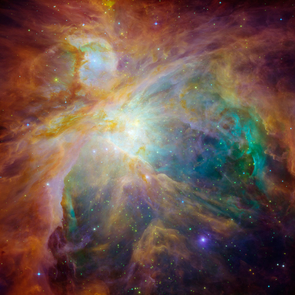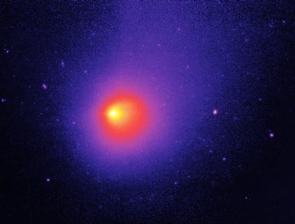UArizona Astronomers Bid Farewell to Spitzer, NASA’s Coldest Space Telescope – UANews
On Jan. 30, NASA switched off the Spitzer Infrared Space Telescope permanently. Part of NASA’s “Great Observatories” fleet, the telescope featured instruments and technology developed at UA and has lifted the veil on hidden objects in nearly every corner of the universe.

The Spitzer Space Telescope has provided glimpses into the very beginnings of our own existence as well as into the far future of our solar system. This infrared image shows the Helix nebula, which is located about 700 light-years away in the constellation Aquarius. Our own sun will blossom into a similar planetary nebula when it dies in about five billion years. (Image: NASA/JPL-Caltech/UArizona)

Spitzer’s retirement brings to a close an era of not only scientific breakthroughs, but also some of the most visually stunning wallpapers gracing screens worldwide. Here, we see baby stars 1,500 light-years away in the cosmic cloud of the Orion Nebula, a cocoon of gas and dust. Infant stars appear as yellow dots embedded in the nebula. (Image: NASA)

In Oct. 2019, UArizona researchers studying comets such as 29P/Schwassmann-Wachmann (seen here by the Spitzer Space Telescope) discovered a region just beyond Jupiter that acts as a “cradle of comets,” funneling icy bodies from deep space into the inner solar system, where they can become regular visitors of Earth’s neighborhood. (Image: NASA)
On Jan. 30 the Spitzer Space Telescope received its final command. After more than 16 years of exploring the cosmos in infrared light, it was switched off permanently, ending its career as one of NASA’s Great Observatories. The spacecraft operated for more than 11 years beyond its prime mission.
Spitzer orbits the sun, trailing about 158 million miles behind Earth – more than 600 times the distance between Earth and the moon. Due to the constraints of its orbit, the angle at which the telescope’s solar panels point away from the sun has increased with each year, resulting in an ever-shorter time window during which it can communicate with Earth. That window would continue to grow shorter year after year if Spitzer continued operating, meaning there is a limit to how long it would be possible to operate the spacecraft efficiently.
Operating in the infrared spectral range, Spitzer specialized in detecting heat radiation to reveal aspects of the universe out of reach to telescopes sensitive to visible light, such as Hubble. Spitzer took advantage of the vacuum of space to operate as cold as -450 degrees Fahrenheit (just 9 degrees above absolute zero, the coldest temperature possible), eliminating its own heat signature, which would have interfered with its observations.
Managed and operated by NASA’s Jet Propulsion Laboratory in Pasadena, California, Spitzer was small but mighty, according to University of Arizona Regents Professor of astronomy George Rieke, who, together with project manager Debbie Wilson, traveled to the Jet Propulsion Laboratory in Pasadena on Jan. 30 “to shed a proud tear.”
Rieke has served as principal investigator for the multiband imaging photometer, or MIPS, a far-infrared camera that gives the Spitzer telescope is ability to see very cold dust. He and his group developed the first large format array of far-infrared detectors at Steward Observatory.
Despite its small aperture of just 34 inches, Spitzer was able to surpass the sensitivity in the infrared of the largest Earth-based telescopes, even the much larger telescopes now in development, due to its low temperature in space, Rieke said.
“Spitzer was a quadrillion times more powerful than the instruments I started with in 1970,” he said. “That’s a thousand trillion! What do you call that? Incredible? Phenomenal? Unbelievable? Words fail. Spitzer’s legacy of data is irreplaceable and will be the foundation of infrared astronomy for decades to come.”
The University of Arizona was intimately involved in all stages of this landmark observatory, from conception to design, Rieke said.
“This strong connection to the mission arose because our Lunar and Planetary Laboratory is where modern infrared astronomy was invented and flourished in the 1960s and 1970s under the leadership of Gerard Kuiper, Harold Johnson and Frank Low,” he said.
In addition to Wilson and Rieke, who oversaw the construction of the MIPS instrument, the late Regents Professor Frank Low served as the telescope scientist, while Marcia Rieke, Regents Professor of astronomy, led the outreach to government officials to secure funding.
Two of the large systematic surveys that kicked off the mission were centered at the university: a study of circumstellar dust disks and another of nearby galaxies.
However, Spitzer’s route to space was bumpy. Fears that the liquid helium needed to cool the telescope would run out led to a plan to mount the telescope in the Space Shuttle, where it would have at most a two-week mission after which it would return to Earth to get more helium – an “amazingly silly idea” in Rieke’s words.
Between 1980 and 1993, the mission metamorphized many times, shedding 88% of its initial weight and 96% of the required load of liquid helium to cool it. The final design, a brainchild of Low’s that harnessed the cold of space to achieve most of the cooling, is a concept that paved the way for the much larger James Webb Space Telescope, which is currently being built.
During its more than 16 years of operation, Spitzer racked up discovery after discovery, many completely unanticipated at the time it was built and launched, Rieke said.
From discovering a vast, never-before-seen ring around Saturn to catching the infrared “echo” of a neutron star left behind by a supernova just 50 years ago, and witnessing the aftermath of a smashup between two embryonic planets possibly as big as Pluto, Spitzer even helped put to rest theories about an “alien mega structure” surrounding an enigmatic star by showing that the star’s peculiar dust cloud was a much more likely explanation.
“It became the go-to telescope to observe transits of exoplanets around other stars, allowing astronomers to discover and study planetary systems other than our own,” he said.
One of Spitzer’s greatest discoveries was Trappist-1, a system just 40 light-years away consisting of seven Earth-sized planets arrayed around a star at distances straddling the habitable zone, raising the interesting possibility of potentially harboring extraterrestrial life.
Spitzer also birthed disciplines that did not yet exist when it was launched, such as studying weather on planets outside of our solar system. Mapping the distribution of temperatures across the surface of exoplanets revealed dense atmospheres and strong stratospheric winds.
Because infrared light penetrates the dust clouds surrounding nascent stars, Spitzer has also revolutionized our understanding of how stars are born and evolve. While the telescope found systems that may be the closest thing to a “baby photo” of our own solar system, in another, particular dramatic discovery, UArizona astronomers caught images of young stars whose surrounding disc of gas and dust – the raw materials for planets – is being blow-torched by nearby energetic hot stars, sealing the fate of any potential planets before they had a chance to form.
Spitzer even spied objects the dawn of the universe, including entire galaxies and some of the most massive black holes known.
“Before launch, astronomers scoffed at the idea that such a small telescope could contribute to our understanding of the most distant galaxies. Now they depend on Spitzer to confirm that candidates are really that far away,” Rieke said.
Rieke added that the most remarkable part of Spitzer is how it grew from a two-week mission to one spanning 16 years, and how its scientific potential continued to expand as high-performance arrays of infrared detectors were developed.
“These technical advances kept the concept current, convinced NASA and Congress to fund it, and were responsible for its discoveries and the legacy of data that astronomers will draw on for many years,” Rieke said.
While Spitzer’s mission is ending, it helped set the stage for NASA’s James Webb Space Telescope, or JWST, which will study the universe in many of the same wavelengths observed by Spitzer. Webb’s primary mirror is about 7.5 times larger than Spitzer’s mirror, meaning Webb will be able to study many of the same targets in much higher resolution and objects that were too far away for its predecessor.
Like Spitzer, Webb also draws from UArizona’s leadership in infrared observation tech: Its Near Infrared Camera, or NIRCam, was designed, built and tested by a UArizona team under Marcia Rieke’s leadership and the Lockheed Martin Space Systems Advanced Technology Center in Palo Alto, California. George Rieke heads the science team overseeing another JWST instrument, MIRI, or Mid-Infrared Imager, which was built in a collaboration among 10 European nations, led by Gillian Wright of the United Kingdom Advanced Technology Center, and NASA (through the Jet Propulsion Laboratory).






